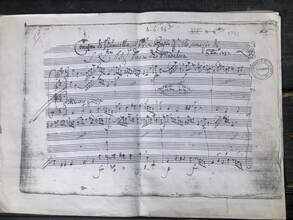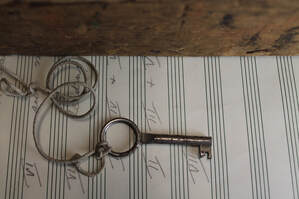The Partimenti – Brief Technical Explanation
 Manuscript of Cello Concerto by Leonardo Leo
Manuscript of Cello Concerto by Leonardo Leo
Robert Gjerdingen, Northwestern School of Music, defined the partimenti like this; "Given just the bass part to an imaginary ensemble of voices or instrumentalists, the Conservatorio students would sit at a keyboard and play all the parts as if they were written out before him.
To accomplish this magic, the young musicians needed to train their memories and imaginations. They practiced a non-verbal form of mental discipline that, when mastered, allowed them to compose sonatas or symphonies with an incredible ease."
Over time, written information was deliberately removed by the Masters, when they were certain that the student no longer needed it.
Consequently this practice led the composers of that time to “simplify” the writing of the score, certain that those who had learned the same method, would know how to reconstruct the missing elements, within a structure that required an understanding of harmony, melody and form that existed beyond the actual manuscript.
The problem arose many years later, when scholars or musicians tried to approach and read the manuscripts.
Since the partimenti method was no longer taught at the Conservatorio, and written information had been erased. it was impossible to understand how the composer could have reached a solution without the procedure being clearly explained.
This caused a distorted understanding of the Neapolitan School, which unfortunately has taken root in modern times; a misunderstanding that caused the composing method of the Neapolitan Masters to be lost, in addition to the onset of approximate and incomplete revisions.
Because I spent more than 15 years studying the partimenti and have been trained to transcribe the manuscripts, I have a clear picture of the contributions of the Neapolitan School. It is not merely a minor school but a major school with major contributions.
What is often seen as partially complete, to me, is not. I understand clearly where and why add the omitted information, according to the method of partimenti.
To accomplish this magic, the young musicians needed to train their memories and imaginations. They practiced a non-verbal form of mental discipline that, when mastered, allowed them to compose sonatas or symphonies with an incredible ease."
Over time, written information was deliberately removed by the Masters, when they were certain that the student no longer needed it.
Consequently this practice led the composers of that time to “simplify” the writing of the score, certain that those who had learned the same method, would know how to reconstruct the missing elements, within a structure that required an understanding of harmony, melody and form that existed beyond the actual manuscript.
The problem arose many years later, when scholars or musicians tried to approach and read the manuscripts.
Since the partimenti method was no longer taught at the Conservatorio, and written information had been erased. it was impossible to understand how the composer could have reached a solution without the procedure being clearly explained.
This caused a distorted understanding of the Neapolitan School, which unfortunately has taken root in modern times; a misunderstanding that caused the composing method of the Neapolitan Masters to be lost, in addition to the onset of approximate and incomplete revisions.
Because I spent more than 15 years studying the partimenti and have been trained to transcribe the manuscripts, I have a clear picture of the contributions of the Neapolitan School. It is not merely a minor school but a major school with major contributions.
What is often seen as partially complete, to me, is not. I understand clearly where and why add the omitted information, according to the method of partimenti.
 Key to my desk where the manuscripts were secured during my training
Key to my desk where the manuscripts were secured during my training
For more than a century, the Neapolitan School of the XVIII century was a teaching method that spread throughout Europe from musicians requested and hired by Royalties, and it was adopted by the major musical institutions among which are Russia, Germany, France, and Austria.
European court musicians were trained in partimenti, or instructional basses, from the late 1600s until the early 1800s. Partimenti had their greatest influence first in Italian conservatories, especially at Naples, and then later at the Paris Conservatory, where the principles of the Neapolitan School continued to be taught far into the twentieth century.
Learning the Neapolitan method was a priority for almost all eighteenth-century musicians, including Bach, Handel, Haydn and Mozart, who also studied partimenti, and many traveled to Naples to work with the Masters.
Unfortunately, for lack of knowledge, over the decades a distorted practice has been incorrectly applied to the Neapolitan repertoire, diminishing the true artistic value of the Neapolitan Masters, relegating them to the role of “School of minors composers."
To me it is a very serious omission that the Neapolitan repertoire is still considered secondary to the more conventional repertoire.
It is an offense to me personally and the sensitivity and intelligence of all those who would like to restore that historical-musical truth. Without any denial, the Neapolitans influenced the development of all baroque, neoclassical and romantic European music.
This is why I have continued to attempt to correct this historical falsification by performing as much as possible, this unique repertoire, according to the method of the Neapolitan Masters.
European court musicians were trained in partimenti, or instructional basses, from the late 1600s until the early 1800s. Partimenti had their greatest influence first in Italian conservatories, especially at Naples, and then later at the Paris Conservatory, where the principles of the Neapolitan School continued to be taught far into the twentieth century.
Learning the Neapolitan method was a priority for almost all eighteenth-century musicians, including Bach, Handel, Haydn and Mozart, who also studied partimenti, and many traveled to Naples to work with the Masters.
Unfortunately, for lack of knowledge, over the decades a distorted practice has been incorrectly applied to the Neapolitan repertoire, diminishing the true artistic value of the Neapolitan Masters, relegating them to the role of “School of minors composers."
To me it is a very serious omission that the Neapolitan repertoire is still considered secondary to the more conventional repertoire.
It is an offense to me personally and the sensitivity and intelligence of all those who would like to restore that historical-musical truth. Without any denial, the Neapolitans influenced the development of all baroque, neoclassical and romantic European music.
This is why I have continued to attempt to correct this historical falsification by performing as much as possible, this unique repertoire, according to the method of the Neapolitan Masters.
